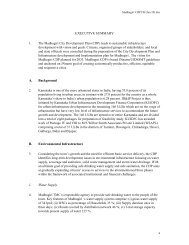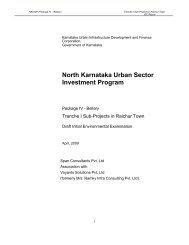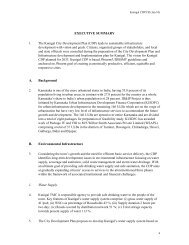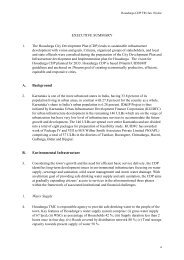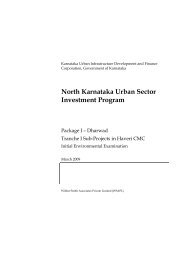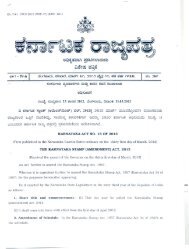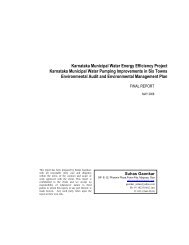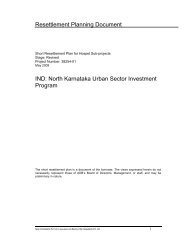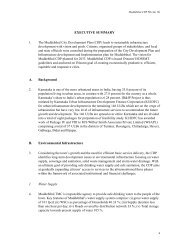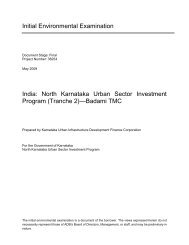Davangere 38254-053-ind-iee-02.pdf - kuidfc
Davangere 38254-053-ind-iee-02.pdf - kuidfc
Davangere 38254-053-ind-iee-02.pdf - kuidfc
You also want an ePaper? Increase the reach of your titles
YUMPU automatically turns print PDFs into web optimized ePapers that Google loves.
21personnel. Based on field experience, 5 to 12 person-hours per year, plus analytical services,will be required. The process produces 0.6 to 0.9 pounds of TSS/pound of BOD removed andrequires between 3.0 and 10 kWh/day for operation. The primary O&M tasks are provided inTable 6.Table 6: Suggested Maintenance for Sequencing Batch Reactor Package PlantsSystems componentSuggested maintenance tasksReaction tankCheck for foaming and uneven air distribution; check for floating scum; checkdecanter operation and adjust as required; adjust cycle time sequences asrequired to achieve effluent target concentrations; check settled sludge volumeand adjust waste pumping to maintain target (mixed liquor volatile suspendedsolids) MLVSS levels.Aeration system-diffused air Check air filters, seals, oil level, and backpressure; perform manufacturer'srequired maintenance.Aeration system-mechanical Check for vibrations and overheating; check oil level, and seals; performmanufacturer's required maintenance.Septic tank (primary clarifier) Check for accumulated solids and order pumping if required.ControlsCheck functions of all controls and alarms; check electrical control box.Sludge wasting Pump waste solids as required to maintain target MLVSS range (typically 500to 4,000 mg/L).AnalyticalMeasure aeration tank grab sample for MLVSS, pH, and settleability; collectfinal effluent decant composite sample and analyze for water qualityparameters as required (BOD, TSS, pH, N, P, etc.).Source: USEPA Onsite Wastewater Treatment Systems Technology Fact Sheet 3 – Sequencing Batch ReactorSystems, available at www.epa.gov/nrmrl/pubs/625r00008/html/tfs3.htm.80. Sludge Management Plan. Desludging is not a day-to-day activity. <strong>Davangere</strong> CMC willremove sludge from the STP once in about one year. Sludge that is drawn out of the pond willcontain 4 -10% solids depending upon the type of sludge. Wet sludge will be applied to the bedsto a depth of 20 to 30 cm. After each layer of dried sludge has been removed, the bed will beraked and leveled. Sludge will never be discharged on a bed containing dried or partially driedsludge. It is preferable to apply the sludge at least a day or two after the sludge cakes areremoved.81. The dried sludge cakes will be sold as fertilizer to farmers as fertilizer after testing thequality to ensure it is safe. concentration of arsenic, cadmium, chromium, copper, lead, mercury,nickel and zinc and C/N Ratio and pH has to be tested and the results should be compared withCompost Standards set by CPCB prior to selling of the dry sludge as manure for agriculturalapplications. Table 7 presents the compost standard set by CPCB.Table 7: CPCB Standard for Using Compost for Agricultural ApplicationsParameters Concentration not to exceed *(mg/kg dry basis , except pH value and C/N ratio)Arsenic 10.00Cadmium 5.00Chromium 50.00Copper 300.00Lead 100.00Mercury 0.15Nickel 50.00Zinc 1000.00C/N ratio 20-40pH 5.5-8.5Source: CPCB.82. Some part of the sludge will be used in the plant itself for gardening, lawns, etc., to



